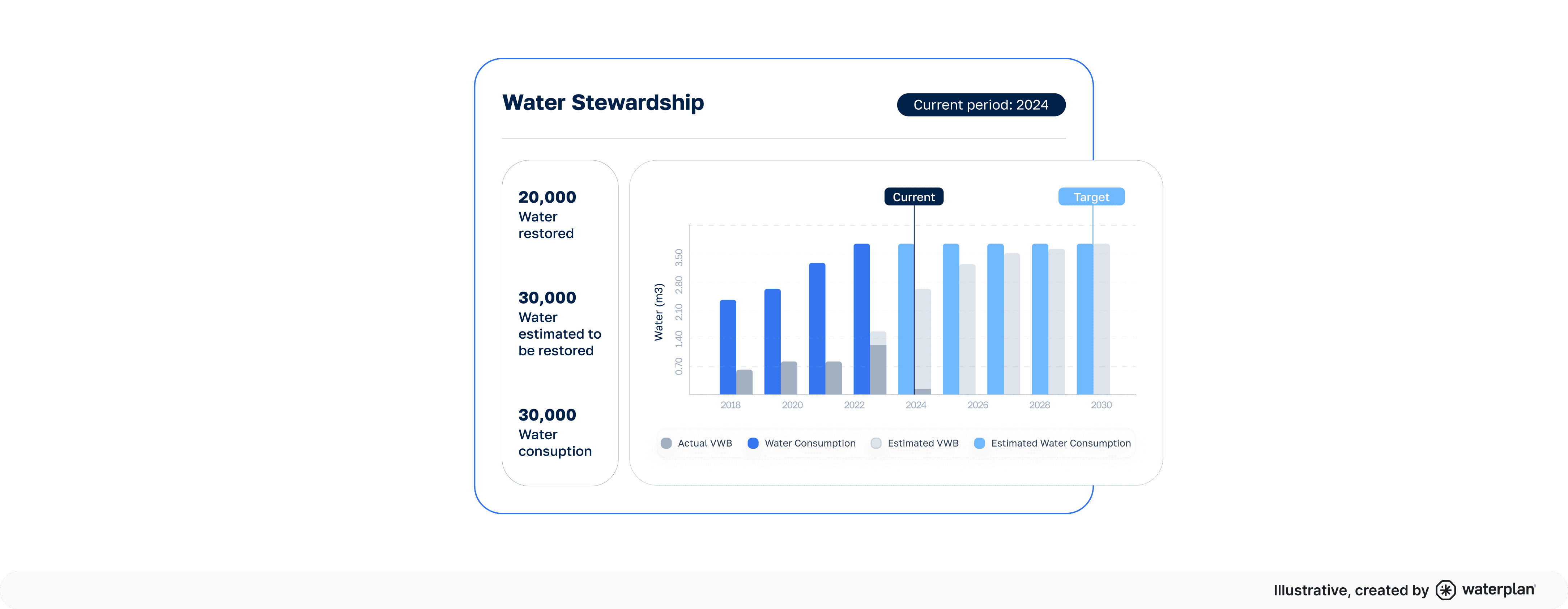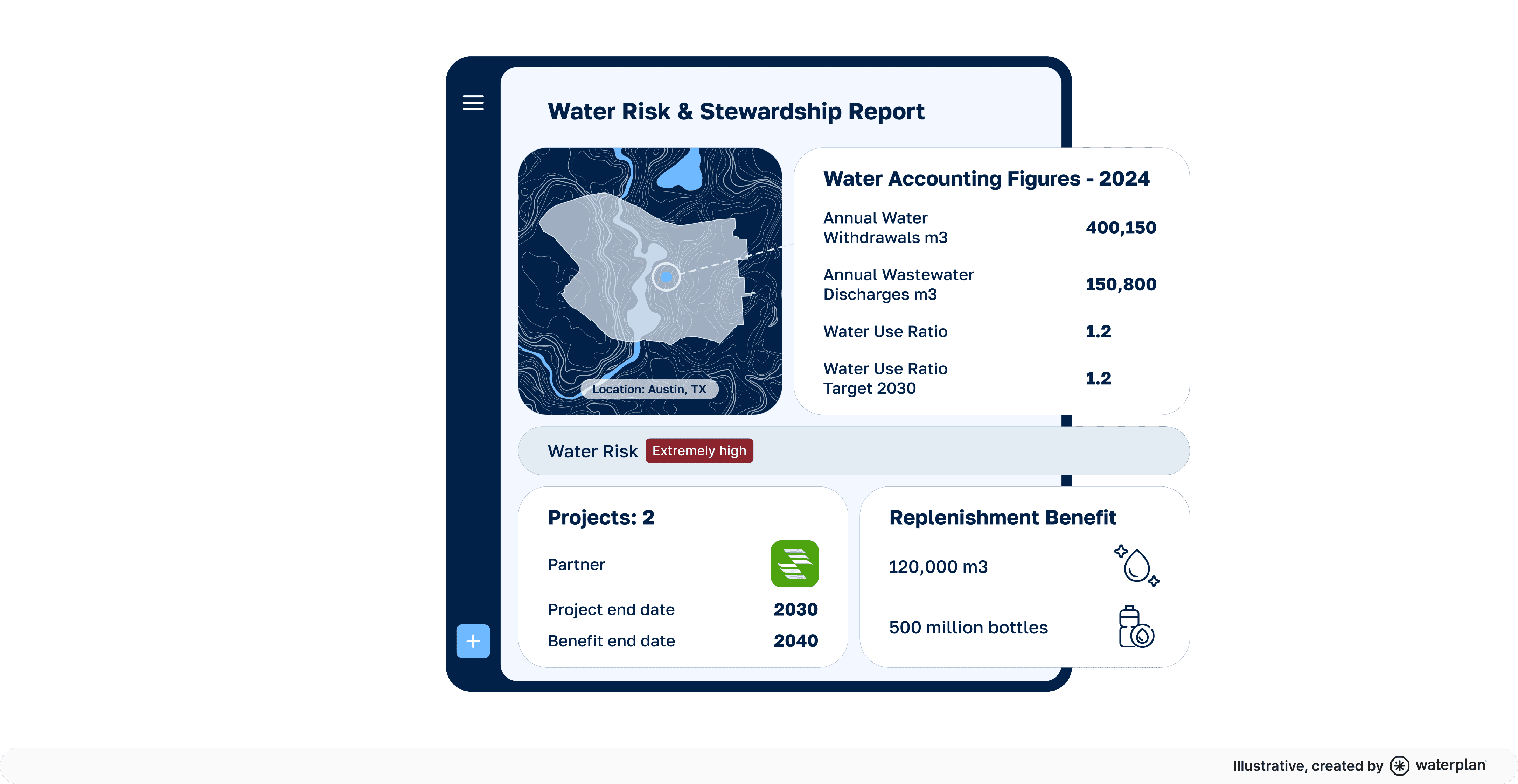If you have identified the water risks your business needs to prioritize for mitigation and adaptation and have established water targets, your next step will be determining what initiatives will enable your organization to achieve your goals. However, it’s usually challenging to identify the appropriate projects to invest in and how to maximize their impact.
This article can help you determine where to start if you want to respond to water risks and achieve impactful results. By reading it, you will learn:
How to ensure projects effectively mitigate and adapt to risks and help achieve targets
The types of water projects to implement
Steps to take when responding to water risks
The internal and external stakeholders involved
Challenges and opportunities, including the role of technology
Introduction to Responding to Water Risk
Effectively Responding to Water Risk
Responding to water risk involves proactive measures and initiatives that sustainability and local teams can take to manage and conserve water resources, ensuring business continuity and compliance. These initiatives can include reducing water consumption, promoting water recycling, addressing water pollution, and engaging in water conservation efforts.
Water initiatives are vital to a company's overall sustainability strategy. However, if local water contexts are overlooked, companies risk making misaligned investments and adopting ineffective strategies. To respond effectively, water targets and action plans must be tailored to each facility’s unique conditions, considering watershed characteristics and the needs of both upstream and downstream users. This customized approach ensures water strategies are impactful, leading to better risk mitigation and target achievement.
To learn more about establishing context-based water targets, read our dedicated blog article.
Types of Water Projects
Water projects typically fall into two categories: internal and external. Below are some common examples:
Internal Initiatives
Also known as “inside-the-fence” initiatives, these often aim to improve water management within the organization's operations. Internal initiatives can focus on improving a site’s water efficiency, reducing absolute water consumption, or limiting the site’s impact on the community or local water bodies. They usually contribute to achieving efficiency targets and mitigating scarcity and/or quality risk. For example:
Water-efficient machinery: this type of machinery requires lower water consumption or has fewer water leakages. These projects often involve incorporating a leak detection system.
As an example, a P&G Feminine Care plant in Maine, US, reduced its production-adjusted water use by 18% in just one year by fixing leaks and improving cooling tower operating systems.
Water recycling and closed-loop systems: Water reuse projects help minimize water withdrawals and waste generation in manufacturing processes.
For example, Brown-Forman has implemented a post-treatment wastewater facility in a Mexico plant to maximize internal water reuse.Alternative water supplies: These projects mitigate reliance on a single supply and can involve treating water from alternative sources. Examples include contracting with a water provider or rainwater harvesting for non-potable uses such as irrigation, cooling systems, and flushing toilets.
For example, Colgate-Palmolive maximizes alternative water sources, such as rainwater or condensation harvesting to help achieve their Net Zero target.Wastewater treatment: Treatment systems manage the quality of water discharged into the environment or to the local municipality’s treatment center.
For example, Metalsa directs used water from its relevant manufacturing facilities to internal treatment plants prior to discharge and is working to improve its treatment processes.
External Initiatives
Also known as “outside-the-fence” initiatives, these extend beyond the organization’s immediate operations and aim to positively impact the broader water environment. This type of initiative usually contributes to achieving water replenishment and/or WASH targets and adapting to scarcity, quality, and/or flooding risk. Examples include:
Watershed restoration: Includes projects such as reforestation, wetland creation or restoration, erosion control measures (such as vegetative buffers), and pollution prevention measures, which can impact water volumes and quality.
For example, Meta has supported projects to restore and protect the San Francisco Bay via the SAFER Bay project, which will create 600 acres of tidal marsh wetlands that can sequester carbon, help control storm surge, and absorb water runoff during the rainy season.Watershed replenishment: These include rainwater harvesting, recharge basins or spreading grounds, and projects aimed at restoring natural water flow regimes in rivers or streams.
For example, Coca-Cola Europacific Partners and The Coca-Cola Company implemented in 2023 a project focused on urban wastewater reuse for irrigation in Tenerife, Spain, a region suffering from scarcity issues.Water, sanitation, and hygiene (WASH) initiatives: These involve collaborating with local communities to improve access to clean and safe drinking water through infrastructure development, water purification systems, and sanitation programs.
For example, AWS has supported WaterAID in implementing piped water systems and groundwater recharge projects in Hyderabad and Andhra Pradesh, India. These projects supply local households with safe water.
Finding the Right Water Project
With so many water project options available, it can be overwhelming to determine what type of project to pursue. Start by identifying the specific water challenges within your facility and its surrounding watershed that you need to address. Many businesses begin with internal water management improvements before expanding to external projects that restore or improve watershed conditions. Engaging with local stakeholders and water experts for advice can also provide valuable insight.
When evaluating different project options, consider factors such as:
Long-term benefits: Does the project help meet your targets and mitigate water risks?
Impact measurement: Are you able to track project progress and impact?
Feasibility: Can the project be realistically implemented? Is the timeline achievable?
Costs: Are project costs clear, and is it within budget?
Stakeholder support: Do you have buy-in from internal and external partners?
Risk of failure: What are the risks of the project not being successful?
Steps to Respond to Water Risk
These are key steps for effectively responding to water risks after identifying them and setting targets:
Aligning with local teams of prioritized sites. Once priority sites for risk mitigation are identified, communicate this clearly to local teams. Use evidence-based data to explain that their facility faces water risks that must be addressed urgently, which you’ve hopefully already discussed with the site teams when identifying risks and setting targets. This clarity is key to gaining their support, as they will be responsible for implementing the mitigation measures.
Build a business case for adaptation. To secure budget and leadership buy-in, build a transparent, data-driven business case that explains the need for investment at the specific site. Incorporate key financial indicators, such as the potential financial impact of water risk (e.g., lost revenue due to facility closures) and the anticipated return on investment (ROI).
Project analysis, selection, and approval. Collaborate with local teams to identify water projects that can effectively address water risk and contribute to meeting long-term targets. Estimate the necessary budget and map out how each project will help progress towards mitigating risk and achieving targets over time. This analysis will guide your project selection process. Once the ideal project is identified, seek approval for investment to move forward.
Partner sourcing: After selecting the project type, identify the partner profile that best aligns with your organization's goals and needs. As this is a strategic partnership, focus on sourcing external partners who not only fit this profile but also have the expertise to effectively assist in implementing the project. External consultants and other water experts can help connect you to on-the-ground partners for both internal and external initiatives.
Develop an implementation plan. Local teams will create a comprehensive implementation plan that outlines project timelines, responsibilities, and key milestones. Ensure the plan is realistic, achievable, and aligned with the overall objectives for water risk mitigation.
Project implementation. Local teams will be responsible for implementing the project and collaborating with external partners if applicable. As a sustainability manager, your main role is to ensure projects are on track and that progress is documented appropriately.
Progress monitoring & reporting: Continuously track the project’s progress, monitoring both performance and budget throughout its duration. Based on initial results, adjust the plan if necessary, and regularly report progress to relevant stakeholders. This ensures transparency, maintains trust, and keeps all parties aligned on the project’s objectives.
Stakeholders Involved
Internal Stakeholders:
C-Suite: Often involved in the target- and strategy-setting phases. Depending on the organization's size, they may also approve the initiatives or the budget.
Global and Regional Sustainability Teams: Often manage the water risk assessment and strategy-setting process. They need access to transparent, evidence-based data on water performance, target achievement progress, and project status for reporting purposes. They also usually assist or enable projects across the company’s entire portfolio.
Local Teams: They include facility managers, engineering or quality managers, and/or Environment, Health, and Safety (EHS) managers. They are directly impacted by water management strategies, and their commitment, actions, and the benefits they derive locally are essential for project success.
Finance and Risk Management Teams: Often not accustomed to water considerations, they can play a vital role in understanding the financial implications, assessing risks, and ensuring financial sustainability.
Operations / Engineering Team: They can collaborate in co-creating strategies, implementing projects, and realizing operational benefits through efficient water management practices.
Legal Team: They review and approve projects from a legal perspective.
Procurement Team: They usually review the project implementation partners.
Communications Team: They are involved in internally and externally communicating project and target progress.
External Stakeholders:
Local Communities: Involving local communities is essential, especially in outside-the-fence projects, such as reforestation where landowners' commitment is necessary for implementation.
Project Partners: They play a vital role in executing water stewardship initiatives effectively; examples are NGOs, contractors, and suppliers.
Auditors: They evaluate and review water stewardship data to ensure it’s accurate for reporting purposes.
Industry Associations/Groups: Engaging with industry associations and groups allows for collaboration, sharing best practices, and collective action on water-related challenges faced by the industry.
Regulators/Government Bodies: Collaboration with regulatory bodies at municipal, regional, or national levels is crucial for compliance, access to resources, and alignment of strategies with broader water management goals.
Challenges & Opportunities
Challenges
Getting support from local teams.
Local teams often have long-standing experience at their sites without encountering significant water-related issues, which can make it difficult to gain their buy-in for new initiatives. To secure their support, it’s crucial to generate awareness and alignment by using evidence-based data that highlights potential risks - including the financial risks - and the benefits of proactive water management.Securing budget for water projects requires a strong business case.
Water is typically a less expensive resource than others, and water projects often deliver long-term ROI, making it difficult to secure immediate budget allocations. Developing a strong business case requires expertise in water management, scenario analysis, and value-at-risk quantification, which many organizations lack. As a result, they frequently turn to external advisors for support.Reporting progress of water projects across multiple locations.
Usually, teams across regions handle data differently or use different terminology, making it complicated and time-consuming to consolidate and report the information on projects.Aligning and collaborating with stakeholders.
Sustainability managers need time, strategic relationships, and transparent information to align all internal and external stakeholders on water initiatives. This can be challenging for teams who are already time- or resource-constrained.
The Opportunity of Technology
Technology and AI can significantly enhance the process to respond to water risk:
Reliable water risk data for local team alignment.
Technology can enhance the reliability of water risk data used in your assessments and project water risks in the future. This provides transparency to local teams and enhances the credibility of the information.Evidence-based business cases.
Technology can provide the required evidence to build business cases to secure budget. Besides enabling the assessment of detailed data on local water conditions, technology can be leveraged for scenario analysis to calculate the value at risk if no investment is made, the return of investment, and how a project enables progress towards water targets.Transparent quantification and monitoring of water benefits.
Technology and AI enable the implementation of the Volumetric Water Benefit Accounting (VWBA) methodology which can be used to quantify the volume of water saved or replenished (1). Besides estimating the VWB of a project before its implementation, leveraging technology enables the remote monitoring of the impact of these projects and tracking progress against targets.

Project portfolio management and reporting.
Technology consolidates all project data into a single platform with standardized formats. You can keep information updated, track progress against targets, review roadmaps, and simplify reporting and auditing for more efficient management.

Enhancing company-wide alignment and collaboration.
Technology provides transparent information and enables collaboration and data sharing across teams, including facility managers, compliance teams, and external auditors.
Conclusion
Responding to water risk requires a nuanced and collaborative approach tailored to the specific risks at each site and the targets you aim to achieve. By leveraging the expertise of professionals and technology solutions, you can effectively identify the right initiatives, secure the necessary budget, track progress, and report on outcomes. Furthermore, establishing strategic relationships and aligning stakeholders around these efforts is crucial to ensure a successful water stewardship plan. Through collaborative approaches we can accelerate the transition to a water-secure world.
Read these articles to learn more about water risks and water targets.
(1) Reig et al., 2019, Volumetric Water Benefit Accounting (VWBA): A Method for Implementing and Valuing Water Stewardship Activities.




